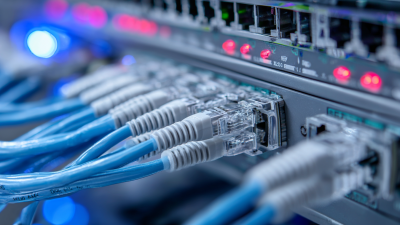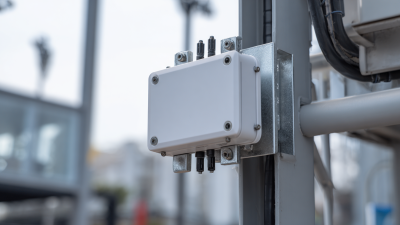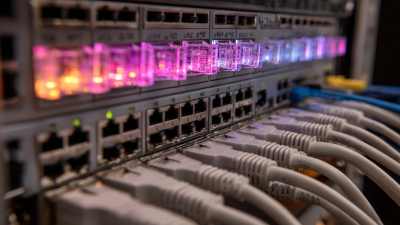
- hasivo@hasivo.com
- Mon - Sat at 7:00AM to 9:00PM
Leave Your Message

In today's fast-paced digital landscape, where seamless connectivity is paramount, the emergence of advanced networking technologies has transformed how we experience the internet. A pivotal innovation in this realm is the 2.5G Switch, which promises to unlock high-speed networking capabilities for both home users and businesses alike. This article delves into the myriad benefits that a 2.5G Switch brings to the table, enhancing bandwidth, reducing latency, and significantly improving overall network performance. As the demand for faster internet speeds continues to escalate, understanding the functionality and advantages of a 2.5G Switch becomes crucial for anyone looking to elevate their online experience.
 Join us as we explore how this cutting-edge technology can revolutionize your connectivity, making buffering and lag a thing of the past while paving the way for a more robust and efficient network infrastructure.
Join us as we explore how this cutting-edge technology can revolutionize your connectivity, making buffering and lag a thing of the past while paving the way for a more robust and efficient network infrastructure.
The evolution of networking technology is rapidly advancing, with 2.5G switches leading the way in enhancing internet connectivity for both home and business users. Understanding the fundamentals of 2.5G technology reveals its significant role in bridging the gap between traditional Gigabit Ethernet and the emerging 5G capabilities. With data transmission speeds reaching up to 2.5 Gbps, these switches enable a high-performance networking environment that supports heavy data users, such as online gamers, content creators, and large enterprises. The recent trend towards integrating 2.5G technology reflects an increasing demand for efficient bandwidth management as internet usage continues to surge.
**Tip:** When selecting a 2.5G switch, consider features like Quality of Service (QoS) and network management capabilities to optimize performance for various applications.
In parallel with the advancements in 2.5G technology, the market for GPON (Gigabit Passive Optical Network) is projected to grow significantly, from $10.5 billion in 2024 to $20.7 billion by 2033. This growth indicates a robust infrastructure that supports next-generation services, including the anticipated roll-out of 10G networks. As organizations seek to future-proof their networking capabilities, adopting 2.5G switches can serve as a stepping stone towards ultimate connectivity solutions that cater to the demands of tomorrow's digital landscape.
**Tip:** Always review the compatibility of 2.5G devices with existing network infrastructure to ensure seamless integration and maximize performance.
| Feature | Description | Benefit |
|---|---|---|
| Speed | Supports data rates up to 2.5 Gbps | Enables faster downloads and streaming |
| Compatibility | Works with existing 1G infrastructure | Offers an easy upgrade path without full replacement |
| Latency | Reduced latency compared to older technologies | Improves real-time applications like gaming and video calls |
| Power Efficiency | Low power consumption based on advanced design | Lowers operating costs and environmental impact |
| Scalability | Easily scalable for growing networks | Future-proofs investment in network infrastructure |
Upgrading to a 2.5G switch can significantly enhance your internet experience, especially in a world increasingly reliant on fast and reliable connectivity. The primary benefits of such an upgrade include improved data transfer speeds, better support for multiple devices, and enhanced network efficiency. With a 2.5G switch, you're not just boosting speed; you're investing in a technology that accommodates the demands of modern smart homes and businesses.
**Tips for Upgrading:**
When considering the switch, evaluate your current network setup. Ensure that your cables and devices support 2.5G speeds to fully capitalize on the upgrade. Additionally, assess the overall bandwidth usage in your environment; this can help you determine if a 2.5G switch is the right choice for your specific needs.
Another key advantage is the ability to future-proof your network. As more devices connect to the internet, having a robust infrastructure in place will ensure a smoother performance. Keep an eye on emerging technologies and consider integrating them into your network strategy to maintain high-speed connectivity across all platforms.
When considering a 2.5G switch to elevate your internet experience, it's essential to focus on key features that significantly enhance connectivity. Look for switches that provide multiple ports, as they allow for flexible network expansion and connection of various devices without compromising speed. A model with a balance of Ethernet ports and SFP+ options can facilitate seamless integration of high-speed fiber connections, making it an excellent choice for both home and small office environments.
Additionally, smart management features can greatly improve network performance. Switches equipped with integrated CPUs enable advanced monitoring and optimization capabilities. Features such as quality of service (QoS) settings can prioritize bandwidth for critical applications, ensuring that your streaming, gaming, or video conferencing experiences remain uninterrupted. Moreover, Power over Ethernet (PoE) support allows devices like security cameras and access points to draw power directly from the switch, simplifying installation and reducing cable clutter.

Setting up a 2.5G networking system can significantly enhance your internet experience, allowing for faster data transfer rates that cater to today’s demands for streaming, gaming, and remote work. A report by the International Data Corporation (IDC) highlights that by 2024, the global demand for improved connectivity will increase by approximately 30%, making high-speed options like 2.5G essential for both homes and businesses. To get started, ensure you have compatible hardware, including a 2.5G switch and network cards that support this standard.
Begin with connecting your 2.5G switch to the modem using a high-quality Ethernet cable to maintain optimal performance. Next, link your network devices—computers, gaming consoles, and smart TVs—to the switch. Configuring the switch can often be done via a web interface; refer to the manufacturer's guidelines to access it. Furthermore, conducting a speed test after setup can help verify that you are receiving the expected bandwidth. According to a study by Gartner, organizations using efficient switching solutions could see up to a 40% increase in productivity due to better collaboration capabilities, illustrating the tangible benefits of upgrading your network infrastructure.

To maximize your internet speed, it's essential to optimize your network setup effectively. One of the most critical steps is to ensure that your router is placed in a central location within your home or office. This optimal positioning helps reduce obstacles that can weaken the signal, allowing for a more consistent and faster connection. Additionally, using modern devices that support the latest Wi-Fi standards can significantly enhance your data transfer rates.
Another effective strategy is to limit the number of connected devices to your network. Each device consumes bandwidth, which can slow down overall performance, especially during peak usage times. Prioritizing essential devices for your work or entertainment needs can help maintain higher speeds. Furthermore, regularly updating your router’s firmware ensures that your network benefits from the latest security enhancements and performance improvements, leading to a smoother internet experience.





